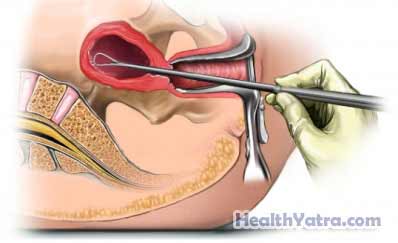Definition
Dilation is a procedure to open and widen the cervix. The cervix is the entrance to the uterus. Curettage is the removal of the lining of the uterus by scraping. The lining is known as the endometrium. The two procedures are done together and are often referred to as a D&C.

Reasons for Procedure
A D&C is usually done to determine what condition is causing abnormal bleeding. Some conditions that may cause abnormal bleeding are:
- Miscarriage
- Hormone imbalances
- Endometrial polyps
- Abnormal endometrial thickening
- Endometrial cancer
Sometimes a D&C is done to stop the bleeding, rather than to diagnose why you are bleeding. For example, this procedure may be done to remove products of conception (eg, tissue from the fetus or placenta) or to treat bleeding that has not responded to other methods.
A D&C is not done if you have an infection (eg, affecting the uterus or fallopian tubes).
Possible Complications
Complications are rare. But no procedure is completely free of risk. If you are planning to have a D&C, your doctor will review a list of possible complications, such as:
- Complications related to anesthesia
- Injury to the cervix
- Scarring of endometrium
- Infection of the uterus or fallopian tubes
- Uterine perforation (hole in the uterus)
- Bleeding
- Damage to other organs in the abdomen
- Need for additional surgery
- Possible need to remove the uterus (hysterectomy)
Factors that may increase the risk of complications include having a pre-existing infection or condition.
What to Expect
Prior to Procedure
Talk to your doctor about all the medicines you are taking. Up to one week before the surgery, you may be asked to stop taking some medicines, such as:
- Aspirin and other nonsteroidal anti-inflammatory drugs (eg, ibuprofen, naproxen)
- Blood-thinning drugs, such as warfarin (Coumadin)
- Anti-platelet drugs, such as clopidogrel (Plavix)
In addition, arrange for a ride home and for help at home.
Anesthesia
General or local anesthesia may be used.
- General anesthesia—keeps you asleep throughout the surgery
- Local anesthesia—numbs the area only
Description of Procedure
A pelvic exam will be done to find out the size and location of your uterus. The vagina and cervix will be cleaned with an antiseptic solution. A speculum will be placed in your vagina. An instrument called a cervical dilator will be placed into the cervical canal. Once the cervical canal is slightly open, a scoop-shaped instrument, called a curette, will be inserted into the uterus. It will be used to scrape the uterine lining and remove tissue through the vagina. After sampling the endometrium, the instrument will be removed from the cervix.
Immediately After Procedure
You will be taken to a recovery room, where the nurses will monitor you.
How Long Will It Take?
You may be able to go home in a few hours.
Will It Hurt?
If you have general anesthesia, you will have no pain during the procedure. With local anesthesia, you may have some cramping and back pain.
After the procedure, pain may last up to 24 hours.
Post-procedure Care
At the Care Center
You will be monitored in the recovery center.
At Home
When you return home, do the following to help ensure a smooth recovery:
- For uterine cramping, take pain medicine if recommended by your doctor.
- It is common to have some vaginal bleeding and discharge after a D&C. Use sanitary pads, not tampons.
- Refrain from placing anything inside your vagina until instructed by your doctor. The cervix has been opened. This may make it easier for you to get an infection in the uterus.
- Ask your doctor when you will be able to return to work. Also, do not drive until your doctor tells you that it is safe. You may be able to resume your normal activities in a few days.
- Be sure to follow your doctor’s instructions.
Your next menstrual cycle may not be regular. It may be late or early.
Call Your Doctor
After arriving home, contact your doctor if any of the following occur:
- Signs of infection, including fever and chills, increasing pain, or foul-smelling vaginal discharge
- Nausea or vomiting that does not stop
- Abdominal pain
- Vaginal bleeding that is saturating more than one sanitary pad per hour
- Cough, shortness of breath, or chest pain
In case of an emergency, call for medical help right away.
